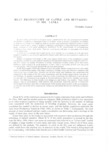Meat Productivity of Cattle and Buffaloes in Sri Lanka
Tropical agriculture research series : proceedings of a symposium on tropical agriculture researches
| ISSN | 03889386 |
|---|---|
| NII recode ID (NCID) | AA00870529 |

Full text
tars18-_217-223.pdf1.09 MB
In beef cattle production in tropical areas, consideration into the genotype-environment interaction is much more important than it is in dairy, swine or poultry production. Investment to improve environmental conditions such as sanitary and nutritional conditions yields a return in most cases in dairy, swine or poultry production with breeds or lines developed in temperate areas, whereas in beef cattle production investment in the improvement of environmental conditions often yields little profit. Thus the local breeds will play an important role in beef cattle production.
A series of experiments and a field survey were carried out to evaluate growth and meat production performance of cattle and buffalo breeds under different environmental conditions in Sri Lanka.
Breed comparisons were made on Dry zone pasture where most of the precipitation occurs during three months in a year and the maximum and minimum temperatures range between 31°C and 26°C. Grass was mainly Brachiaria brizantha. Indigenous animals, Lanka cattle and Lanka buffaloes, were found to be good producers of beef, with a reasonable growth rate and good carcass quality. The Friesians showed the poorest performance.
In the Mid-country where the climate is more favorable, breed comparisons were also made under cut-and-feeding regime with some concentrate feeding. Grass was Panicum maximum and concentrate was coconut cake. Growth rate of both cattle and buffaloes was much improved compared to the results in the Dry zone experiments, and the largest improvement was seen in the Friesians. In another experiment with two levels of nutrition, the difference of growth rate between the two treatments was largest in Murrah buffaloes, followed by Ayrshire and Jersey breeds. The difference in Zebu breeds, both indigenous and Indian, was smaller. These results indicate that as environments, both climatic and nutritional, improved, growth of temperate breeds improved more than that of Zebu breeds. With limited improvement of the environments, as was the case in the above experiments, indigenous and Indian breeds are still better producers of beef.
A series of experiments and a field survey were carried out to evaluate growth and meat production performance of cattle and buffalo breeds under different environmental conditions in Sri Lanka.
Breed comparisons were made on Dry zone pasture where most of the precipitation occurs during three months in a year and the maximum and minimum temperatures range between 31°C and 26°C. Grass was mainly Brachiaria brizantha. Indigenous animals, Lanka cattle and Lanka buffaloes, were found to be good producers of beef, with a reasonable growth rate and good carcass quality. The Friesians showed the poorest performance.
In the Mid-country where the climate is more favorable, breed comparisons were also made under cut-and-feeding regime with some concentrate feeding. Grass was Panicum maximum and concentrate was coconut cake. Growth rate of both cattle and buffaloes was much improved compared to the results in the Dry zone experiments, and the largest improvement was seen in the Friesians. In another experiment with two levels of nutrition, the difference of growth rate between the two treatments was largest in Murrah buffaloes, followed by Ayrshire and Jersey breeds. The difference in Zebu breeds, both indigenous and Indian, was smaller. These results indicate that as environments, both climatic and nutritional, improved, growth of temperate breeds improved more than that of Zebu breeds. With limited improvement of the environments, as was the case in the above experiments, indigenous and Indian breeds are still better producers of beef.
| Date of issued | |
|---|---|
| Creator | Shinobu OZAWA |
| Publisher | Japan International Research Center for Agricultural Sciences |
| Volume | 18 |
| spage | 217 |
| epage | 223 |
| Language | eng |
